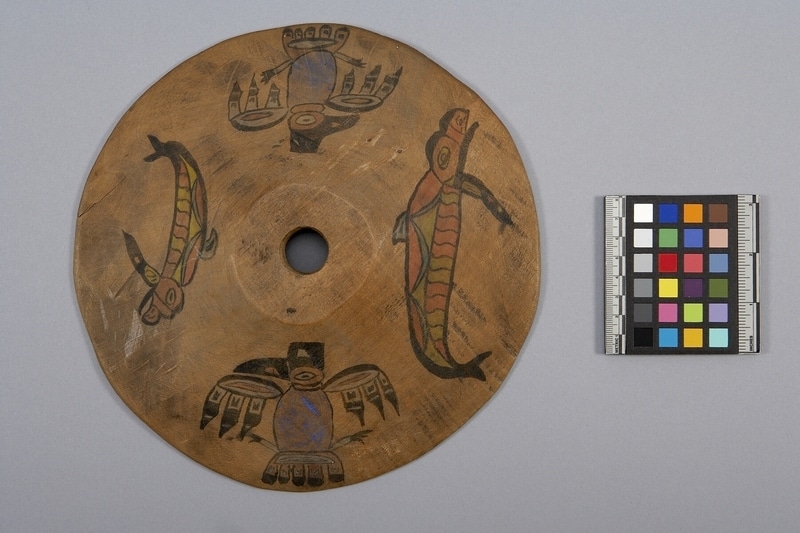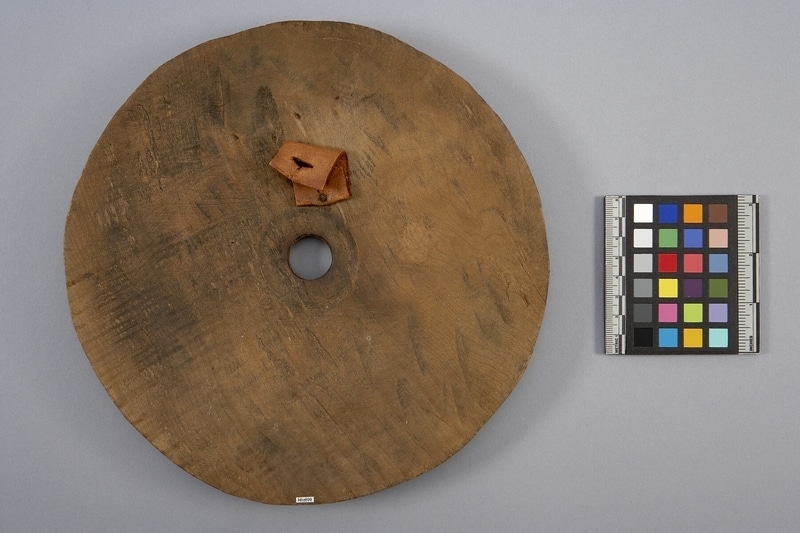Spindle Whorl Item Number: Nbz899 from the MOA: University of British Columbia


Description
Round wooden spindle whorl with a hole in its centre. The top surface is convex with a flat ring around the hole and is painted with animal designs: raven and killer whale. The whales are predominantly orange with yellow accents, while the ravens are blue with orange accents. The back is slightly concave (with a small leather strap nailed into wood).
History Of Use
Homer Barnett (1955) notes that spindle whorls used by the southern Coast Salish of BC are larger than those used in the north, with a shaft that is twice as long as the whorl. In the north, fibres were spun on smaller whorls that were "twirled between the leg and palm (1955:118)." By contrast, whorls such as this one were used to spin fibres that were suspended from overhead. This arrangement created a tension in the roving. Johnson and Bernick (1986) report that traditionally several different techniques were used for turning the spindle, however, contemporary weavers now make use of a spinning machine that is similar in appearance to a treadle sewing machine.
Cultural Context
weaving; spinning; decorative art
Iconographic Meaning
The sea mammals represent sea-lions, while the birds represent ravens. The sea lions resemble petroglyphs from the same area: sea-lion petroglyphs have been documented at Aldridge Point, which is located nearby Metchosin in East Sooke. Archaeologists Beth and Ray Hill report that: "Long years ago a great supernatural animal like a sea-lion killed many of the Beecher Bay Indians when canoeing. The tribe became nearly extinct; the remaining members were afraid to go on the water until one day a mythical man caught the sea-lion and turned him into the stone representation as seen on Aldridge Point (1974:57)."
Narrative
Tom Richardson purchased the spindle whorl from Mrs. McVicker. Maude McVicker owned property near Metchosin, on southern Vancouver Island, and ran 'The Hobbies Shop' in Victoria.
Item History
- Made in Vancouver Island, British Columbia, Canada between 1900 and 1950
- Collected in Metchosin, British Columbia, Canada
- Owned by Maude McVicker
- Owned by Thomas R. Richardson before 1998
- Owned by Frances M. Richardson before November 18, 1998
- Received from Frances M. Richardson (Donor) on November 18, 1998
What
- Name
- Spindle Whorl
- Identification Number
- Nbz899
- Type of Item
- spindle whorl
- Material
- wood, paint, metal and leather skin
- Manufacturing Technique
- carved, painted and nailed
- Overall
- height 2.8 cm, diameter 24.4 cm
Who
- Culture
- Coast Salish: T'Sou-ke ?
- Previous Owner
- Maude McVicker, Thomas R. Richardson and Frances M. Richardson
- Received from
- Frances M. Richardson (Donor)
Where
- Holding Institution
- MOA: University of British Columbia
- Made in
- Vancouver Island, British Columbia, Canada
- Collected in
- Metchosin, British Columbia, Canada
When
- Creation Date
- between 1900 and 1950
- Ownership Date
- before 1998 and before November 18, 1998
- Acquisition Date
- on November 18, 1998
Other
- Condition
- good
- Accession Number
- 1768/0044